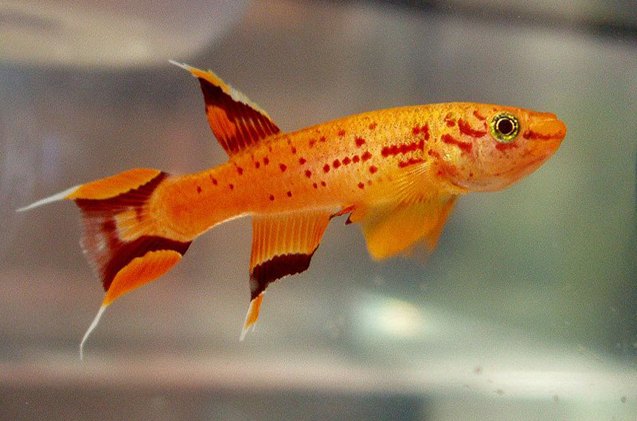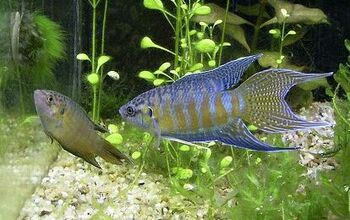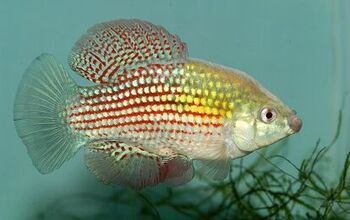Killifish


About Killifish
Killifish are a large family of freshwater fish comprising over a thousand different species. Most species are no more than an inch or two in size, and the largest species often only reach a length of 6 inches. Most aquarium varieties are vividly colored and have medium length, brightly colored fins. These fish are extremely hardy and also exhibit many fascinating behavior patterns. This makes them a popular choice among beginner and more experienced aquarists alike.
Most killifish available for purchase are referred to by their scientific names, which can make choosing somewhat difficult for the beginner aquarist. It is advisable to first familiarize yourself with the different scientific names and descriptions of various species through industry specific journals like the Journal of the American Killifish Association before setting out to purchase your own specimens.
Killifish are a large family of freshwater fish comprising over a thousand different species.
Killifish originate in many different regions of the world including Norm America, Central America, South America, Africa and Eurasia.
Most killifish come in a mixture of vibrant colors ranging from blue, red, gold, green, orange, silver and brown.
Killifishes are an extremely hardy species of aquarium fish and most aquarium bred varieties can adapt to a range of different water conditions. They’re often kept in smaller aquariums of 5 gallons or less which makes observing them easier. Filtration and aeration is an important consideration in the killifish aquarium because smaller sized tanks tend to accumulate harmful toxins much faster. It is advisable to use a small box type filter or sponge filter in the aquarium. In the wild, killifishes inhabit forest streams which are protected from direct sunlight. For this reason they prefer aquariums with subdued lighting. A heavily planted aquarium with surface growing plants like duckweed can be used to create a dimly lit aquarium which killifish will thrive in.
One more important thing to remember when rearing killifish is that they are spectacular jumpers. Even the tiniest of cracks in an aquarium cover is enough for a killifish to jump through. For this reason killifish aquarists should take special care to ensure that their tanks are securely covered with an overhead lid.
Most killifish purchased from pet stores will readily accept flake type foods, but it is important to supplement the killifish’s diet with a variety of live foods such as brine shrimp, daphnia, mosquito larvae, tubifex worms, black worms, white worms and fruit flies.
Killifish are an extremely hardy species of aquarium fish and most aquarium bred varieties can adapt to a range of different water conditions.
Different species of killifishes have different spawning methods. Some are referred to as plant spawners and spawn on submerged or floating plants. Other species of killifishes are known as gravel spawners and lay their eggs on the gravel bed of the aquarium. Certain species of killifishes even burrow a few inches deep into the substrate to lay their eggs. Thus it is important to identify the spawning behavior of your killifishes before setting up a breeding tank. Also it is important to note that some species of killifish eggs require a period of dry incubation before being hatched. These periods can vary from a few weeks to even longer than a year. Once spawning has occurred, the eggs should either be harvested from the breeding tank or the parent fish should be removed because killifishes fill readily devour any eggs or fry that they come across. The fry can be fed on baby brine shrimp, infusoria or micro worms until they are large enough to accept crushed flakes.
Lyretail Killifishes, Medaka Killifishes, Rainbow Killifishes, Ceylon Killifishes, Striped Killifishes
Photo credit: Alexander Prokoshev/Wikimedia; Violaine2/Wikimedia

Amy Tokic, Editor of PetGuide.com, is a passionate animal lover and proud pet parent of Oscar, a Shih Tzu/Chihuahua cross, and Zed, a Japanese Chin. Her love of animals began in kindergarten, when she brought her stuffed dog Snoopy into class with her every day. Now, she writes about her adventures in pet ownership and tirelessly researches products, news and health related issues she can share with other animal enthusiasts. In her free time, Amy loves perusing used book and record stores, obsessing over the latest pet products available and chasing squirrels with wild abandon (a habit attributed to spending too much time with her pooches).
More by Amy Tokic
























